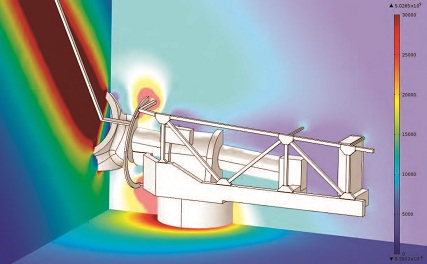
Here’s a story we’ve all heard before: due to the inefficient nature and inevitable decline of fossil fuels, alternative energy resources are becoming increasingly popular. Wind energy is a popular source of alternative energy, with wind farms sprouting up all over the world. Here’s something you may not have thought about: lightning strikes are a major problem for these wind turbines. Intuitively, places with high wind speeds also have stormy weather, and a 150 meter tall metal pole makes an attractive target for lightning strikes. In fact, some extreme wind turbine sites experience 10 lightning strikes a day!
When lightning strikes a turbine, a powerful current flows through it creating a magnetic field, as shown in the image below. Both the current, and resulting magnetic field can interfere and damage the equipment in the nacelle, the housing that protects and covers the drive components in the turbine. The big challenge for the engineers designing these turbines is where to place the panels that shield the electronics, as to limit the effect of the lightning strikes. Engineers usually rely on physical testing of turbines and their individual components, as well as field experience, to design future systems. This is an expensive process, up to 500,000 Euros for a set of tests on one nacelle. As is usually the case, multiphysics modeling is a cheaper and more efficient process.

Illustration of the magnetic field after 200 kA @ 25 kHz lightning strikes one of the blades.
Global Lightning Protection Services A/S (GLPS) is an engineering consultant firm specializing in lightning protection. Søren Find Madsen, one of their engineers, found that finite element method (FEM) modeling using COMSOL Multiphysics is an effective way to couple the effects of the lightning. Coupling different physics analyses into one model is COMSOL’s core strength. Since the 3D CAD model of a wind turbine is so detailed, Madsen first used LiveLink™ for SpaceClaim® to remove the unnecessary features of the geometry to allow the solver to efficiently compute the solutions. Once that was finished, a series of realistic scenarios were run in COMSOL to model the effects of the lightning strikes. The results allowed GLPS to advise their clients on shielding requirements, as well as other factors, instead of relying solely on standards set up by the International Electrotechnical Commission.
To read more about the modeling and results of these analyses, refer to page 29 of the Multiphysics Simulation insert in the IEEE Spectrum magazine.




Comments (0)